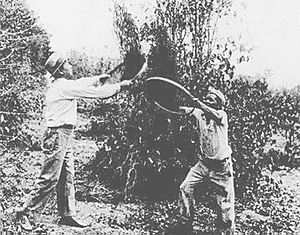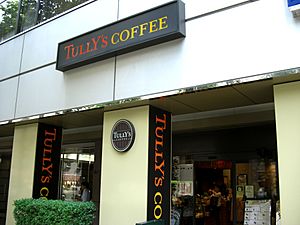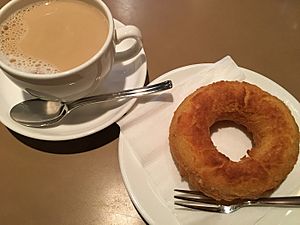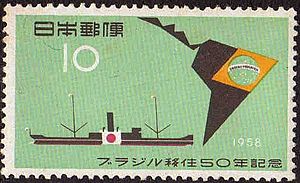Coffee in Japan facts for kids
Japan has a special way of enjoying coffee that has changed over time. Today, coffee shops are important places in Japanese cities. Coffee first came to Japan a long time ago, in the 1500s and 1600s, brought by traders from the Dutch and Portuguese. It became very popular around the early 1900s. Coffee helps people connect with each other, but it also gives them a place to relax from daily life. Coffee also shows differences in social groups and has a big impact on Japan's economy because so much coffee is bought and sold there.
Contents
History of Coffee in Japan
Coffee first arrived in Japan in 1700, brought by Dutch traders. The first coffee shop opened in 1888. It was called Kahiichakan, but it closed after five years.
In 1933, a man named Tadao Ueshima started his coffee company, Ueshima Tadao Shoten, in Kobe. People now call Ueshima the "Father of Coffee in Japan."
During World War II, Japan stopped all coffee imports until 1950. But in 1969, Ueshima created and sold the first canned coffee. This made it easy for people to drink coffee anywhere. Some famous canned coffee brands today include "Boss" (by Suntory), "Georgia" (by Coca-Cola), "Nescafe" (by Nestlé), and "Roots" (by Japan Tobacco).
After a short break, coffee became popular again in Japan in the 1960s. Japan imported 15,000 tons of coffee in 1960. Today, that number is over 440,000 tons! Japan's love for coffee grew because it was interested in Western cultures. Mr. Ueshima also helped start the All Japanese Coffee Association in 1980.
In the same year, Doutor Coffee opened Japan's first chain of coffee shops. This made coffee even more popular and important for the economy. Doutor's success came from its "on-the-go" style. This made it easy for people to grab coffee and take it to work or school.
Different Kinds of Coffee Shops
Smaller coffee shops try hard to stay open by offering special things. For example, Renoir is known for having power outlets and Wi-Fi for customers. Another thing is smoking rules. Some customers like to smoke with their coffee, while others don't want any smoke. Smaller shops can let locals smoke, but big chains like Starbucks must follow company rules and ban it.
Big chains like McDonald's and Starbucks came from Western countries. They have opened many stores and stands in Japan, joining the growing coffee market. The first Starbucks in Japan opened in Ginza, Tokyo, in 1996. In 2005, Starbucks worked with Suntory to sell its own canned coffee. Now, Starbucks has over 1,000 shops in Japan, mostly in cities.
In response, McDonald's McCafe started opening small stands that only sell coffee and small snacks. These stands began in 2007. Tully's is another foreign coffee company from Seattle, USA. Its first shop opened in 1997, and by 2014, it had 513 shops.
These days, convenience stores are selling more and more coffee in Japan. For example, Seven-Eleven sells 1.1 billion take-out coffees every year.
Coffee Culture in Japan
Coffee culture in Japan is very special. One interesting custom is that the coffee cup handle is usually placed on the left side for the drinker, and the spoon handle faces right.
Because coffee came from other countries, Japanese coffee culture is often linked to being foreign or Western. This is why coffee was even banned during World War II. Western coffee shops like Starbucks are enjoyed in Japan in the same way as Disneyland. Japan was the first country outside the US to have a Starbucks.
After World War II, Western products were a sign of the new middle class in Japan. Good coffee machines and ground coffee were part of this. In post-war Japan, jazz cafés and their coffee showed Japan's efforts to become more modern, like Western countries. Coffee shops were also places for young people in the 1960s and 1970s. They were meeting spots for groups working for women's rights and against the government.
Coffee culture is quite different from traditional Japanese tea culture. In the West, coffee is often seen as a drink you have alone. Japan has a similar view. In the 1960s and 1970s, coffee became popular with Japanese business people who were working alone in public.
However, Japanese coffee also has a social side, but it's different from the social side of Japanese tea. Tea ceremonies in Japan are about bringing people together, showing kindness and respect to friends and guests. Coffee shops also have a social role, but it's more about change. In the 1970s and 1980s, coffee shops in Japan were places where groups met to try and change Japanese society. These groups included feminist groups and anti-government movements.
Coffee also shows differences between age groups. Instant coffee is seen as common, while ground and fresh coffee beans are seen as luxury items. Young people in Japan often prefer instant coffee, while successful middle-class adults enjoy ground coffee.
Japan's Global Coffee Connections
Making coffee in Japan is connected to the whole world. The coffee beans sold in Japan mostly come from countries like Brazil, Indonesia, and other warm places. Between 1908 and 1924, about 35,000 Japanese people moved to Brazil to work on coffee farms. These Japanese Brazilians later brought coffee back to Japan.
Japan's coffee culture has also adopted English words for coffee terms, like "roast" and "drip," instead of making up Japanese words.
Coffee brands in Japan often use Western actors like Brad Pitt and Tom Selleck in their ads. This also shows that coffee is seen as a foreign product.
Coffee and the Economy
In the past, coffee shops did very well during Japan's "bubble economy," a time of fast economic growth. In 2019, the average money made by coffee shops was about 4,075,994 yen, which is about $37,478 million in US dollars.
The most popular type of coffee is instant coffee. In 2019, it made about 3,016,157 yen, or $27,733 million US dollars. The price of instant coffee has gone up a bit recently, but the price of roasted coffee has stayed about the same.
Most coffee in Japan is drunk outside the home, in places like cafes and restaurants, rather than at home. The biggest company selling coffee in stores is Nestlé. The largest company for both in-home and out-of-home coffee is JAB Holdings, which is based in Luxembourg.
Over the last ten years, the money made from coffee in Japan has steadily increased. Globally, Japan is the third country that makes the most money from coffee.





